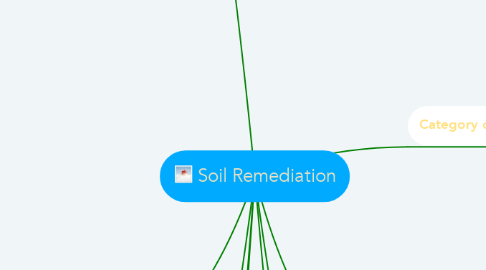
1. Remediation technique
1.1. Biological
1.1.1. Bioventing
1.1.1.1. technique applied in unsaturated zones
1.1.1.2. Uniquely targets benzene, acetone, toluene, phenol and their derivatives
1.1.1.3. Advantages
1.1.1.3.1. easily accessible and short time treatment
1.1.1.3.2. Cost competitive process
1.1.1.3.3. availability of equpment and easy installation technique
1.1.1.4. Disadvantages
1.1.1.4.1. contaminants intoxicate micro-organism
1.1.1.4.2. Not ideal for all soil species e.g heavy clay
1.1.2. Green remediation
1.1.2.1. Phyto extraction
1.1.2.1.1. pollutants absorbed and stores in shoots, roots and stem
1.1.2.1.2. not efficient for trees that store pollutants in leaves, seeds and fruits
1.1.2.2. Phytovolatisation
1.1.2.2.1. Uptake and transport pollutants in plant vascular tissues then moves pollutants to leaves were they are expelled in volatile form
1.1.2.3. Rhizodegradation
1.1.2.3.1. technique destroys pollutants in the root zones
1.1.2.3.2. plants concern release sugars, alcohols, nutrients and acids to enhance living conditions of micro-organisms
1.1.2.4. Photodegradation
1.1.2.4.1. utilises enzymes to decompose PCBs, PCPs, Pesticides, Herbicides
1.1.2.5. phytostabilisation
1.1.2.5.1. roots trabs and absorb pollutants to limit their migration thus avoiding leaching, erosion and soil dispersion of pollutants
1.2. Physical
1.2.1. Soil replacement
1.2.1.1. Soil sprading
1.2.1.2. New soil importong
1.2.2. Soil isolation
1.2.3. Vitrification
1.2.3.1. Advantages
1.2.3.1.1. Easy application method
1.2.3.1.2. applied in variety of contaminants
1.2.3.2. Limitations
1.2.3.2.1. High cost due to huge energy demands
1.2.4. Electrokinetic remediation
1.2.4.1. electrophoresis
1.2.4.2. Electric seepage
1.2.4.3. Electro migration
1.2.4.4. Advantages
1.2.4.4.1. easy application technique
1.2.4.4.2. economically efficient
1.2.4.4.3. Maintains soil nature
1.2.4.5. Set backs
1.2.4.5.1. pH needs to be checked
1.2.4.5.2. requires soil with low permeability
1.3. Chemical
1.3.1. Immobilization
1.3.1.1. Action mode
1.3.1.1.1. reduces metal mobility and bio availability by applying immobilizing amendment
1.3.1.2. Advantages
1.3.1.2.1. fast and easy method
1.3.1.2.2. low cost
1.3.1.3. Disadvantages
1.3.1.3.1. Not long term solution
1.3.1.3.2. Requires constant checking
1.3.2. Encapsulation
1.3.2.1. Operation mode
1.3.2.1.1. Entails mixing contaminated soil with other products such as Lime, Asphalt
1.3.2.2. uses immobilisation agents such as Polyvinylalcohol, chitosan, polyurethanes
1.3.3. Soil washing
1.3.3.1. by reagents e.g EDTA, EDDS
1.3.3.2. By extractants
1.3.3.3. Process
1.3.3.3.1. Removes heavy metals from soil by extractants and form stable complexes
1.3.3.4. Advantages
1.3.3.4.1. cost efficient
1.3.3.4.2. reduces long term liability
1.3.3.5. Limitations
1.3.3.5.1. released washings are environmentally unfriendly
1.3.3.5.2. efficiency depends on soil type and contaminants present
2. Other remediation methods
2.1. Soil washing followed by oxone oxidation
2.1.1. Very efficient with Surfactant and PHE( TX-100 and Brij-35
2.1.2. Deterioration rate affected by benzene rings
2.2. Electrical Resistance heating
2.2.1. Mode of action
2.2.1.1. 35 copper electrodes are installed in system
2.2.1.2. filling pipes contain 3 storage tanks
2.2.1.3. Most cost efficient method
3. Metal systems as a device in soil remediation
3.1. Heterogeneous systems
3.1.1. Minerals
3.1.1.1. method based on absorbent material
3.1.1.2. can be used in soil and water
3.1.1.3. E.g Biotite, apatite, chlorite, limestone, pyrite.
3.1.2. Bulk Inorganic compounds
3.1.3. Metal containing NPs
3.1.3.1. Metal oxides NPs
3.1.3.2. Metal NPs
3.1.3.3. Bimetallic NPs
3.1.4. Zerovalent Iron (ZVI) and ZVI- NPs
3.2. Homogeneous and Fenton-type
3.2.1. Permanganate
3.2.2. Persulphate
3.2.3. Ozone
3.3. Electrokinetic Phenomena
3.3.1. Electrophoresis
3.3.2. Electroosmosis
3.3.3. Streaming
4. Negative impacts
4.1. reducing rate of photosynthesis in plants
4.2. Interferes plants growth life
4.3. causes upper gastrointestinal cancer
4.4. varies Nitrogen metabolism
4.5. Destroy plant species and kill animals
5. Purification method selection criteria
5.1. Determine by the following factors
5.1.1. remediation purpose
5.1.2. Financial budget
5.1.3. contamination characteristics
5.1.4. Cost effectiveness
5.1.5. General acceptability of technique
5.1.6. implementation aptness of method
6. Category of pollutants
6.1. Natural sources
6.1.1. From the earth crust
6.1.2. E.g Hg, Pb, Cd, Fe, Zn, Co, Zn
6.2. Anthropogenic sources( refining $ mining)
6.2.1. Agricultural e.g Cu, Se, U
6.2.2. Industrial e.g Ni, Cr, Cd
6.2.3. Metalliferous mining and smelling e.g Cd, As, Hg
6.2.4. Waste disposal e.g As, Pb, Cd
6.2.5. Atmospheric deposits e.g Pb, Cr, U
7. contaminated areas
7.1. Soil
7.2. Debris
7.3. Groundwater
7.4. Sources
8. Well managed purification project
8.1. involves the following steps
8.1.1. 1) technology prescreening and treatability study scoping
8.1.2. 2) Remedial investigation (RI) of polluted site
8.1.3. 3) Feasibility study ( FS) of prescreened technique
8.1.4. 4) Determination of best remediation method (ROD)
8.1.5. 5) Design and implementation of remediation practises ( RD/RA)
8.1.6. 6) Evaluation of remediation performance
9. Economic aspects
9.1. Cost depend on
9.1.1. Soil type
9.1.2. Depth of soil
9.1.3. Height of groundwater
9.1.4. Concerntration of contaminants

